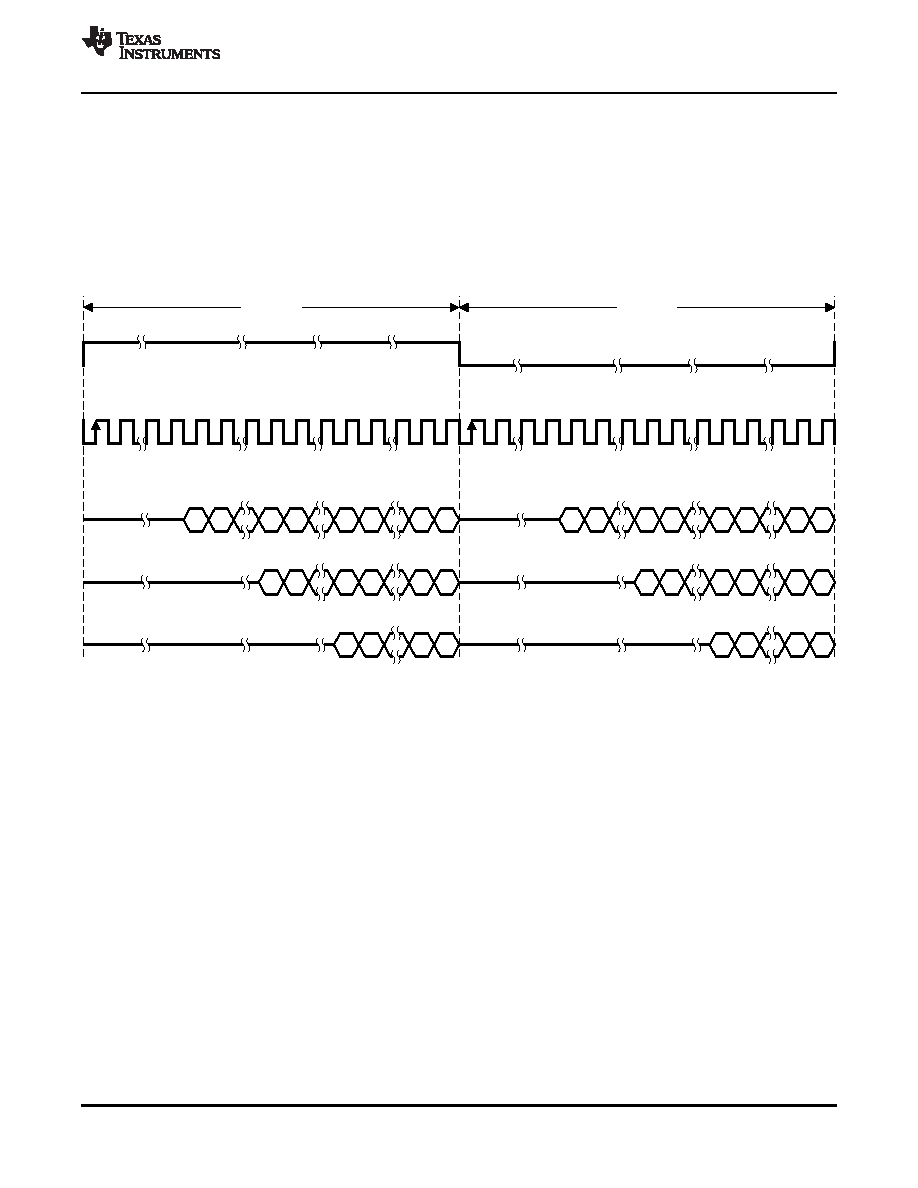- 您現(xiàn)在的位置:買賣IC網 > PDF目錄98158 > TAS3204PAGR (TEXAS INSTRUMENTS INC) SPECIALTY CONSUMER CIRCUIT, PQFP64 PDF資料下載
參數(shù)資料
| 型號: | TAS3204PAGR |
| 廠商: | TEXAS INSTRUMENTS INC |
| 元件分類: | 消費家電 |
| 英文描述: | SPECIALTY CONSUMER CIRCUIT, PQFP64 |
| 封裝: | GREEN, PLASTIC, TQFP-64 |
| 文件頁數(shù): | 7/76頁 |
| 文件大小: | 1224K |
| 代理商: | TAS3204PAGR |
第1頁第2頁第3頁第4頁第5頁第6頁當前第7頁第8頁第9頁第10頁第11頁第12頁第13頁第14頁第15頁第16頁第17頁第18頁第19頁第20頁第21頁第22頁第23頁第24頁第25頁第26頁第27頁第28頁第29頁第30頁第31頁第32頁第33頁第34頁第35頁第36頁第37頁第38頁第39頁第40頁第41頁第42頁第43頁第44頁第45頁第46頁第47頁第48頁第49頁第50頁第51頁第52頁第53頁第54頁第55頁第56頁第57頁第58頁第59頁第60頁第61頁第62頁第63頁第64頁第65頁第66頁第67頁第68頁第69頁第70頁第71頁第72頁第73頁第74頁第75頁第76頁

23
22
SCLK
32Clks
LRCLK
LeftChannel
24-BitMode
1
20-BitMode
16-BitMode
15
14
MSB
LSB
SCLK
32Clks
RightChannel
2-ChannelRight-Justified(SonyFormat)StereoInput
T0034-03
19
18
1
19
18
1
0
15
14
15
14
23
22
1
15
14
MSB
LSB
19
18
1
19
18
1
0
15
14
15
14
www.ti.com
SLES197C – APRIL 2007 – REVISED MARCH 2011
4.1.3
2-Channel Right-Justified Timing
In 2-channel right-justified (RJ) timing, LRCLK is HIGH when left-channel data is transmitted and LOW
when right-channel data is transmitted. SCLK is a bit clock running at 64 × fS which clocks in each bit of
the data. The first bit of data appears on the data lines 8 bit-clock periods (for 24-bit data) after LRCLK
toggles. In the RJ mode, the last bit clock before LRCLK transitions always clocks the LSB of data. The
data is written MSB first and is valid on the rising edge of the bit clock. The TAS3204 masks unused
leading data-bit positions.
Figure 4-4. Right-Justified 64fS Format
4.1.4
SAP Input to SAP Output—Processing Flow
All SAP data format options other than I2S result in a two-sample delay from input to output. If I2S
formatting is used for both the input SAP and the output SAP, the polarity of LRCLK must be inverted.
However, if I2S format conversions are performed between input and output, the delay becomes either 1.5
samples or 2.5 samples, depending on the processing clock frequency selected for the audio DSP core
relative to the sample rate of the incoming data.
The I2S format uses the falling edge of LRCLK to begin a sample period, whereas all other formats use
the rising edge of LRCLK to begin a sample period. This means that the input SAP and audio DSP core
operate on sample windows that are 180° out of phase with respect to the sample window used by the
output SAP. This phase difference results in the output SAP outputting a new data sample at the midpoint
of the sample period used by the audio DSP core to process the data. If the processing cycle completes
all processing tasks before the midpoint of the processing sample period, the output SAP outputs this
processed data. However, if the processing time extends past the midpoint of the processing sample
period, the output SAP outputs the data processed during the previous processing sample period. In the
former case, the delay from input to output is 1.5 samples. In the latter case, the delay from input to output
is 2.5 samples.
Copyright 2007–2011, Texas Instruments Incorporated
Digital Audio Interface
15
Product Folder Link(s): TAS3204
相關PDF資料 |
PDF描述 |
|---|---|
| TAS3204PAG | SPECIALTY CONSUMER CIRCUIT, PQFP64 |
| TAS3218IPZPR | SPECIALTY CONSUMER CIRCUIT, PQFP100 |
| TAS3218IPZP | SPECIALTY CONSUMER CIRCUIT, PQFP100 |
| TAS3218PZPR | SPECIALTY CONSUMER CIRCUIT, PQFP100 |
| TAS3218PZP | SPECIALTY CONSUMER CIRCUIT, PQFP100 |
相關代理商/技術參數(shù) |
參數(shù)描述 |
|---|---|
| TAS3208 | 制造商:TI 制造商全稱:Texas Instruments 功能描述:DIGITAL AUDIO PROCESSOR WITH ANALOG INTERFACE |
| TAS3208EVM | 功能描述:音頻 IC 開發(fā)工具 TAS3208EVM Eval Mod RoHS:否 制造商:Texas Instruments 產品:Evaluation Kits 類型:Audio Amplifiers 工具用于評估:TAS5614L 工作電源電壓:12 V to 38 V |
| TAS3208EVM-LC | 功能描述:音頻 IC 開發(fā)工具 TAS3208 Low Cost EVM RoHS:否 制造商:Texas Instruments 產品:Evaluation Kits 類型:Audio Amplifiers 工具用于評估:TAS5614L 工作電源電壓:12 V to 38 V |
| TAS3208IPZP | 功能描述:音頻 DSP Dual Core Dig Aud Proc RoHS:否 制造商:Texas Instruments 工作電源電壓: 電源電流: 工作溫度范圍: 安裝風格: 封裝 / 箱體: 封裝:Tube |
| TAS3208IPZPR | 功能描述:音頻 DSP Dual Core Dig Aud Proc RoHS:否 制造商:Texas Instruments 工作電源電壓: 電源電流: 工作溫度范圍: 安裝風格: 封裝 / 箱體: 封裝:Tube |
發(fā)布緊急采購,3分鐘左右您將得到回復。